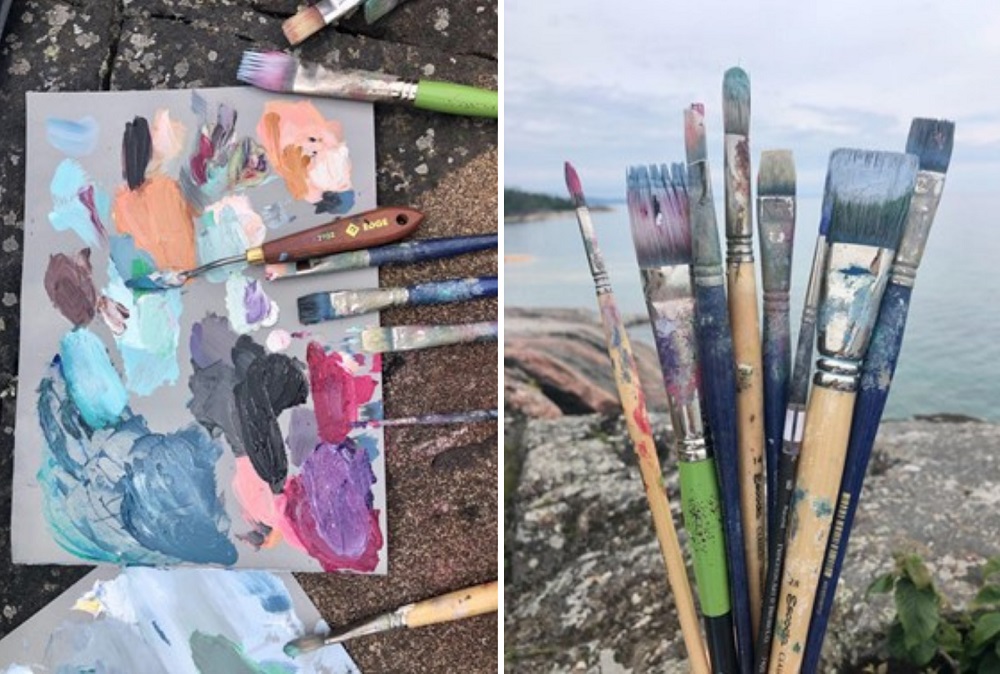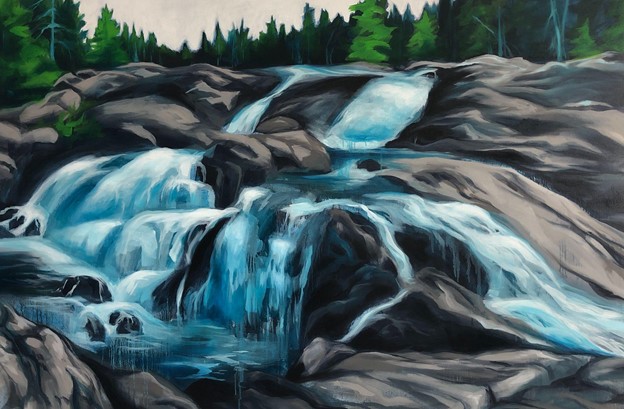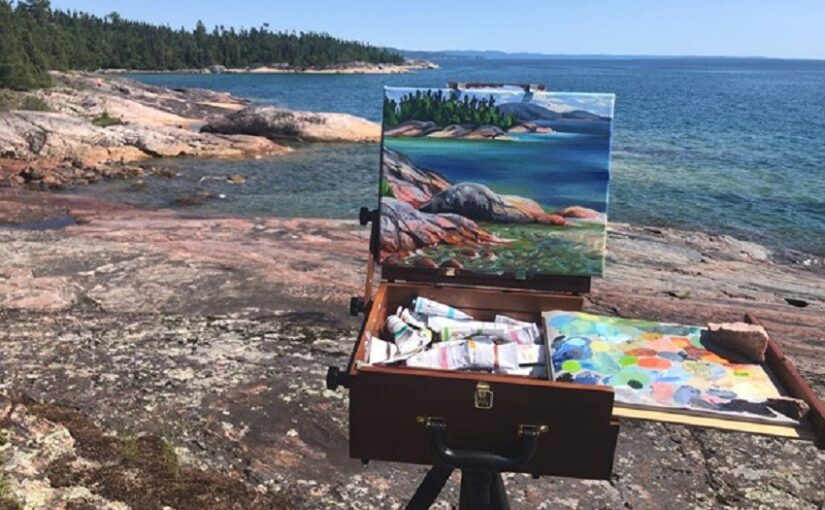Today’s post comes from Marta Stares, the Friends of Lake Superior Provincial Park‘s first artist-in-residence.
In 2021, Lake Superior Provincial Park and the Friends of Lake Superior Provincial Park established its first Artist-in-Residence program.
I was honoured to be selected as the park’s first ever participant, and to be able to paint and capture the stunning landscape of the park.
With its rugged coast, tall cliffs, remote beaches, waterfalls, and scenic lookouts, it’s easy to see why generations of artists have found inspiration here.
About the program
The annual program is organized and sponsored by the Friends of Lake Superior Provincial Park.
The program offers an honorarium, supplies stipend, meal and travel allowance, seven nights free camping at either campground (Agawa Bay or Rabbit Blanket) or backcountry camping, as well as marketing and promotion of artwork.
In exchange for my stay, I provided an artwork of choice and a virtual Art Talk public webinar about my experience and the work I produced (watch the Art Talk on the Friends of Lake Superior events page!).
About the artist
I am a Toronto-based artist and educator interested in painting the outdoors, especially the northern Ontario landscape.
 The inspiration for my work comes from extended canoe and backcountry camping trips.
The inspiration for my work comes from extended canoe and backcountry camping trips.
During these remote excursions I find a deep sense of connection with water and land.
I work primarily with oils and use bold, vibrant colours in my work, offering viewers a glimpse into what it feels like to experience Canadian wilderness.
You can view more of my work here.
The experience
If you’re familiar with the Algoma region, you know there is inspiration and cultural heritage in every corner.
Just like the lake itself, everything about the park is picturesque and grand.

The way sunlight moves over the shore of Lake Superior always reminds me of Lawren Harris’ paintings.
I was both excited and nervous to paint here, worried that I may not be able to do this spectacular place justice.
 While I was preparing and packing art supplies for the residency, I thought about all the magnificent landmarks I intended to capture on canvas.
While I was preparing and packing art supplies for the residency, I thought about all the magnificent landmarks I intended to capture on canvas.
To my surprise, what I created was inspired by the small, intimate places and quiet moments.
The most profound part of the experience was having the time to be fully present in nature, aware of my senses, to savour the little things, and to capture a moment in time.
The memory of being there continues to influence my studio practice even today.
During the residency I spent time journaling every morning, hiking the coast, listening to the boreal forest, watching sunsets, making quick sketches, and painting en plein air.
En plein air
Occasionally, I set up my phone on a small tripod and filmed snippets of myself in action. I wanted to have a record of this special experience.
Painting plein air is a completely different experience from painting in the studio, which is a controlled space where I can adjust the light, make a cup of tea, and paint with many layers.
In my studio I have the luxury of time. I can work slowly, reference multiple photos, and overthink every mark if I want to.
Painting outside means being fully immersed in the environment, and embracing the challenges it brings.

For example, there are bugs — many of them! Sometimes tiny sand flies or pesky mosquitoes can make it impossible to complete a small painting in one session.
Another challenging part of plein air painting is simplifying the subject without being overwhelmed by the vast view. There are so many shapes, colours, and details in a landscape. It can be quite tricky to translate them into just a few, simple brushstrokes.

Perhaps the most difficult part of plein air painting is the changing light.
The sun hiding behind a cloud for a moment can quickly change the entire look of the view. Painting in Lake Superior was definitely a race against time — it forced me to make quick decisions and paint with more confidence.
Finding my special spots
I had many memorable moments in different corners of this stunning park.
I visited this beautiful spot just south of the Coldwater River a few times. I loved the variations of pink rocks and the texture of brightly coloured green lichen set against turquoise water.

My first attempt at painting here was unsuccessful. Shortly after I set up my easel and put on my first colours, the wind picked up so abruptly it took my canvas with it!
So many bugs and debris were stuck to the fresh oil paint, I didn’t think the painting was salvageable.
Determined, I returned to the same spot the next day and completed this small painting.
This was one of my favourite painting moments.

Another day, I was alone in a very popular spot at Katherine Cove on a foggy morning, except for the resident snake who kept me company.
The rocks felt cool underneath my feet, the light stayed consistent for hours, and the gentle sound of water lapping against the rocks was my background music — it was perfect.

I revisited the Sand River Trail many times during the residency. Every time I learned something new about the way the water cascaded down the rocks.
This path, a trail used by the Anishinaabe since time immemorial, left a lasting impression on me.
Back in the studio, I painted Pinguisibi Falls again, this time on a large 60 by 48 inch canvas.

From this viewpoint the falls are grand, fierce and full of energy. This painting, called Pinguisibi, is the one I have chosen to donate. It will be available for viewing in the park’s Agawa Bay Visitor Centre.
It has been a privilege to have the opportunity to make art in this remarkable place. I have collected great source material during my stay, enough to be inspired and continue painting Lake Superior for years to come.
The most valuable source material, however, is the experience itself – being immersed in nature.
If you are an artist looking for an inspiring place to create new pieces, I recommend you consider applying to the Friends of Lake Superior Provincial Park’s Artist-in-Residence Program for the upcoming season.
Interested in becoming Lake Superior’s second artist-in-residence?
Applications for the 2022 Lake Superior Provincial Park Artist-in-Residence Program are due by March 31, 2022.
For more information and to apply, please visit the Friends of Lake Superior’s website.

